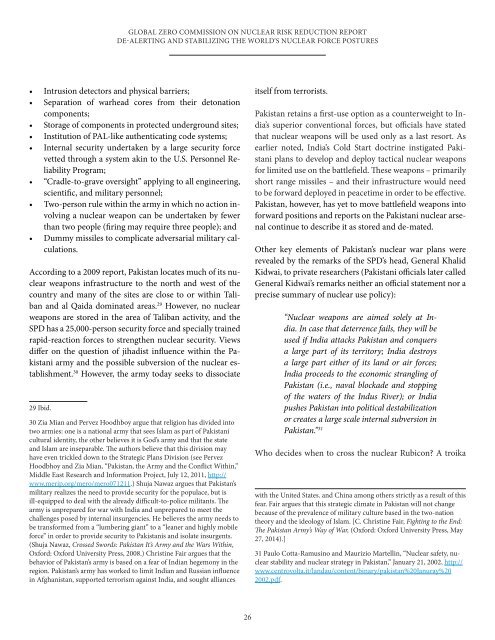global_zero_commission_on_nuclear_risk_reduction_report
global_zero_commission_on_nuclear_risk_reduction_report
global_zero_commission_on_nuclear_risk_reduction_report
You also want an ePaper? Increase the reach of your titles
YUMPU automatically turns print PDFs into web optimized ePapers that Google loves.
GLOBAL ZERO COMMISSION ON NUCLEAR RISK REDUCTION REPORTDE-ALERTING AND STABILIZING THE WORLD’S NUCLEAR FORCE POSTURES• Intrusi<strong>on</strong> detectors and physical barriers;• Separati<strong>on</strong> of warhead cores from their det<strong>on</strong>ati<strong>on</strong>comp<strong>on</strong>ents;• Storage of comp<strong>on</strong>ents in protected underground sites;• Instituti<strong>on</strong> of PAL-like authenticating code systems;• Internal security undertaken by a large security forcevetted through a system akin to the U.S. Pers<strong>on</strong>nel ReliabilityProgram;• “Cradle-to-grave oversight” applying to all engineering,scientific, and military pers<strong>on</strong>nel;• Two-pers<strong>on</strong> rule within the army in which no acti<strong>on</strong> involvinga <strong>nuclear</strong> weap<strong>on</strong> can be undertaken by fewerthan two people (firing may require three people); and• Dummy missiles to complicate adversarial military calculati<strong>on</strong>s.According to a 2009 <strong>report</strong>, Pakistan locates much of its <strong>nuclear</strong>weap<strong>on</strong>s infrastructure to the north and west of thecountry and many of the sites are close to or within Talibanand al Qaida dominated areas. 29 However, no <strong>nuclear</strong>weap<strong>on</strong>s are stored in the area of Taliban activity, and theSPD has a 25,000-pers<strong>on</strong> security force and specially trainedrapid-reacti<strong>on</strong> forces to strengthen <strong>nuclear</strong> security. Viewsdiffer <strong>on</strong> the questi<strong>on</strong> of jihadist influence within the Pakistaniarmy and the possible subversi<strong>on</strong> of the <strong>nuclear</strong> establishment.30 However, the army today seeks to dissociate29 Ibid.30 Zia Mian and Pervez Hoodhboy argue that religi<strong>on</strong> has divided intotwo armies: <strong>on</strong>e is a nati<strong>on</strong>al army that sees Islam as part of Pakistanicultural identity, the other believes it is God’s army and that the stateand Islam are inseparable. The authors believe that this divisi<strong>on</strong> mayhave even trickled down to the Strategic Plans Divisi<strong>on</strong> (see PervezHoodbhoy and Zia Mian, “Pakistan, the Army and the C<strong>on</strong>flict Within,”Middle East Research and Informati<strong>on</strong> Project, July 12, 2011, http://www.merip.org/mero/mero071211.) Shuja Nawaz argues that Pakistan’smilitary realizes the need to provide security for the populace, but isill-equipped to deal with the already difficult-to-police militants. Thearmy is unprepared for war with India and unprepared to meet thechallenges posed by internal insurgencies. He believes the army needs tobe transformed from a “lumbering giant” to a “leaner and highly mobileforce” in order to provide security to Pakistanis and isolate insurgents.(Shuja Nawaz, Crossed Swords: Pakistan It’s Army and the Wars Within,Oxford: Oxford University Press, 2008.) Christine Fair argues that thebehavior of Pakistan’s army is based <strong>on</strong> a fear of Indian hegem<strong>on</strong>y in theregi<strong>on</strong>. Pakistan’s army has worked to limit Indian and Russian influencein Afghanistan, supported terrorism against India, and sought alliancesitself from terrorists.Pakistan retains a first-use opti<strong>on</strong> as a counterweight to India’ssuperior c<strong>on</strong>venti<strong>on</strong>al forces, but officials have statedthat <strong>nuclear</strong> weap<strong>on</strong>s will be used <strong>on</strong>ly as a last resort. Asearlier noted, India’s Cold Start doctrine instigated Pakistaniplans to develop and deploy tactical <strong>nuclear</strong> weap<strong>on</strong>sfor limited use <strong>on</strong> the battlefield. These weap<strong>on</strong>s – primarilyshort range missiles – and their infrastructure would needto be forward deployed in peacetime in order to be effective.Pakistan, however, has yet to move battlefield weap<strong>on</strong>s intoforward positi<strong>on</strong>s and <strong>report</strong>s <strong>on</strong> the Pakistani <strong>nuclear</strong> arsenalc<strong>on</strong>tinue to describe it as stored and de-mated.Other key elements of Pakistan’s <strong>nuclear</strong> war plans wererevealed by the remarks of the SPD’s head, General KhalidKidwai, to private researchers (Pakistani officials later calledGeneral Kidwai’s remarks neither an official statement nor aprecise summary of <strong>nuclear</strong> use policy):“Nuclear weap<strong>on</strong>s are aimed solely at India.In case that deterrence fails, they will beused if India attacks Pakistan and c<strong>on</strong>quersa large part of its territory; India destroysa large part either of its land or air forces;India proceeds to the ec<strong>on</strong>omic strangling ofPakistan (i.e., naval blockade and stoppingof the waters of the Indus River); or Indiapushes Pakistan into political destabilizati<strong>on</strong>or creates a large scale internal subversi<strong>on</strong> inPakistan.” 31Who decides when to cross the <strong>nuclear</strong> Rubic<strong>on</strong>? A troikawith the United States. and China am<strong>on</strong>g others strictly as a result of thisfear. Fair argues that this strategic climate in Pakistan will not changebecause of the prevalence of military culture based in the two-nati<strong>on</strong>theory and the ideology of Islam. [C. Christine Fair, Fighting to the End:The Pakistan Army’s Way of War, (Oxford: Oxford University Press, May27, 2014).]31 Paulo Cotta-Ramusino and Maurizio Martellin, “Nuclear safety, <strong>nuclear</strong>stability and <strong>nuclear</strong> strategy in Pakistan,” January 21, 2002, http://www.centrovolta.it/landau/c<strong>on</strong>tent/binary/pakistan%20Januray%202002.pdf.26


